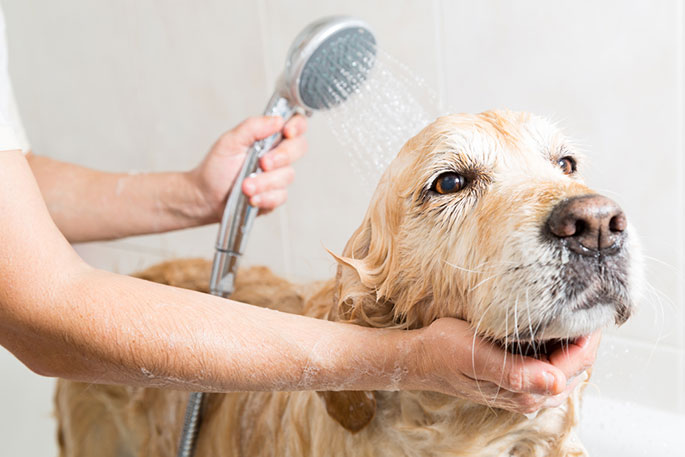
Bathing your dog is an essential part of their grooming routine, helping to keep their coat clean, reduce odors, and maintain skin health. However, not all dogs enjoy bath time, and improper techniques can cause stress or skin issues. This comprehensive guide will help you understand the best ways to bathe your dog, ensuring a positive experience for both you and your furry friend.
1. Gather the Necessary Supplies
Before starting the bath, make sure you have all the supplies you need:
Dog-Specific Shampoo and Conditioner:
- Use a shampoo and conditioner formulated for dogs to avoid irritating their skin. Human shampoos can be too harsh and cause dryness or allergic reactions.
Brush:
- Brush your dog’s coat before the bath to remove tangles, mats, and loose fur. This also helps the shampoo penetrate the coat more effectively.
Non-Slip Mat:
- Place a non-slip mat in the tub or bathing area to prevent your dog from slipping and feeling insecure.
Towels:
- Have plenty of towels on hand to dry your dog after the bath. Microfiber towels are particularly absorbent.
Cotton Balls:
- Use cotton balls to gently plug your dog’s ears and prevent water from getting inside, which can cause infections.
Spray Hose or Pitcher:
- A spray hose or pitcher can help you wet and rinse your dog thoroughly.
Treats and Toys:
- Use treats and toys to reward your dog and keep them calm during the bath.
2. Prepare the Bathing Area
Choose a suitable location for bathing your dog. A bathtub, a large sink, or a designated pet bathing station can work well. If the weather is warm, you can also bathe your dog outside using a hose, but be cautious of water temperature and pressure.
Water Temperature:
- Use lukewarm water. Water that is too hot or too cold can be uncomfortable or even harmful to your dog.
Secure the Area:
- Make sure the area is secure to prevent your dog from escaping mid-bath. Close doors or gates as necessary.
3. Brush Your Dog’s Coat
Brushing your dog’s coat before the bath is crucial to remove any tangles, mats, and loose fur. This step ensures that the shampoo can reach the skin and clean effectively. For dogs with long or thick coats, consider using a detangling spray to make brushing easier.
4. Wet Your Dog Thoroughly
Use a spray hose, pitcher, or cup to wet your dog’s coat thoroughly. Start at the neck and work your way down to the tail, making sure the water penetrates through the fur to the skin. Avoid spraying water directly on your dog’s face.
5. Apply Shampoo and Conditioner
Shampoo:
- Apply a dog-specific shampoo, starting from the neck and working towards the tail. Use your hands to lather the shampoo into the coat, ensuring it reaches the skin. Be gentle and avoid the eyes, ears, and mouth.
Conditioner:
- If using a conditioner, apply it after rinsing out the shampoo. Follow the same process, ensuring even coverage.
Rinse Thoroughly:
- Rinse your dog thoroughly to remove all shampoo and conditioner residues. Leftover products can irritate the skin and cause itching.
6. Clean the Face and Ears
Use a damp cloth or sponge to gently clean your dog’s face. Be careful around the eyes and ears. To clean the ears, use a cotton ball dampened with water or a vet-recommended ear cleaner. Never insert anything into the ear canal.
7. Dry Your Dog Properly
Towel Dry:
- Use absorbent towels to dry your dog as much as possible. Pat the fur dry rather than rubbing, as rubbing can cause tangles or frizz, especially in dogs with long coats.
Blow Dry:
- If your dog tolerates it, use a blow dryer on a low heat setting to dry the fur completely. Keep the dryer moving to avoid overheating any area.
Air Dry:
- In warm weather, you can let your dog air dry naturally, but ensure they are in a draft-free area to prevent chills.
8. Reward and Praise
Reward your dog with treats, praise, and affection throughout the bathing process to make it a positive experience. This reinforcement will help your dog associate bath time with good things, reducing anxiety in future baths.
9. Frequency of Baths
The frequency of baths depends on your dog’s breed, coat type, activity level, and any skin conditions. Generally, dogs should be bathed once a month, but some may require more frequent baths. Consult your veterinarian for specific recommendations.
10. Special Considerations
Sensitive Skin:
- If your dog has sensitive skin or allergies, choose a hypoallergenic or medicated shampoo recommended by your vet.
Puppies:
- Be gentle with puppies and introduce them to bathing gradually. Use a mild puppy shampoo and make the experience as positive as possible.
Senior Dogs:
- Older dogs may have joint issues or other health concerns. Use a non-slip mat and be gentle to ensure their comfort.
Conclusion
Bathing your dog doesn’t have to be a stressful experience. By gathering the right supplies, preparing the bathing area, and following these steps, you can make bath time a positive and enjoyable activity for both you and your dog. Regular baths are essential for maintaining your dog’s hygiene and overall health, so it’s worth investing time in getting the process right. Happy bathing!



